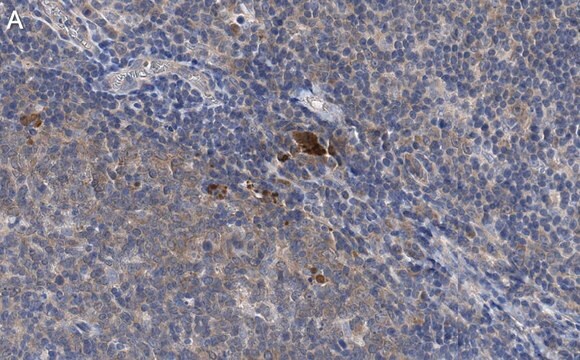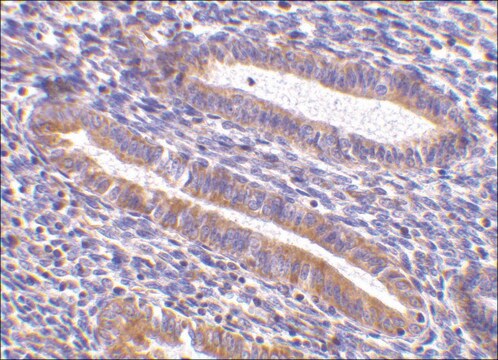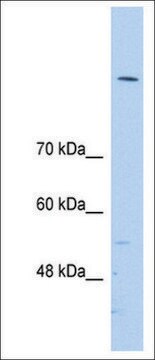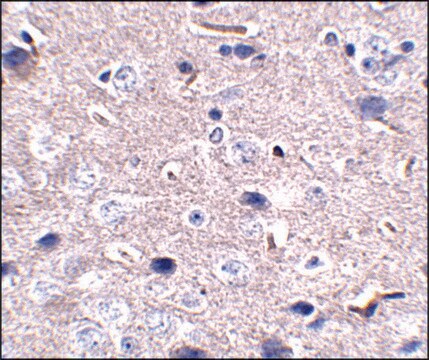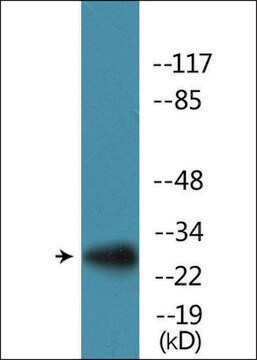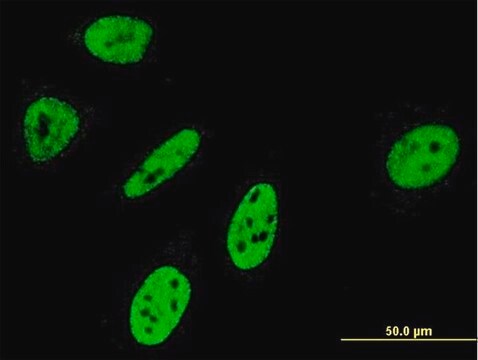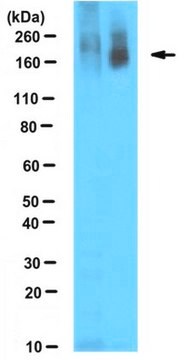MABF245
Anti-TIM-1 Antibody, clone 3B3
clone 3B3, from rat
别名:
Hepatitis A virus cellular receptor 1 homolog, HAVcr-1, Kidney injury molecule 1, KIM-1, T cell immunoglobulin and mucin domain-containing protein 1, T-cell immunoglobulin mucin receptor 1, T cell membrane protein 1, TIM-1, TIMD-1
登录查看公司和协议定价
所有图片(1)
About This Item
分類程式碼代碼:
12352203
eCl@ss:
32160702
推荐产品
生物源
rat
品質等級
抗體表格
purified antibody
抗體產品種類
primary antibodies
無性繁殖
3B3, monoclonal
物種活性
mouse
技術
flow cytometry: suitable
同型
IgG2aκ
NCBI登錄號
UniProt登錄號
運輸包裝
ambient
目標翻譯後修改
unmodified
基因資訊
human ... HAVCR1(26762)
一般說明
Hepatitis A virus cellular receptor 1 homolog (UniProt Q5QNS5; also known as HAVcr-1, Kidney injury molecule 1, KIM-1, T cell immunoglobulin and mucin domain-containing protein 1, T-cell immunoglobulin mucin receptor 1, T cell membrane protein 1, TIM-1, TIMD-1) is encoded by the Havcr1 (also known as Kim1, Tim1, Timd1) gene (Gene ID 171283) in murine species. TIM‐1/KIM‐1 is a phosphatidylserine phagocytosis and scavenger receptor expressed on kidney proximal tubule epithelial cells and, at a much lower level, also among a subset of immune cells. Upon kidney injury, TIM‐1 is upregulated more than a thousand fold and assists tissue injury recovery through phagocytosis of apoptotic cells and cellular debris. KIM‐1‐mediated phagocytosis leads to pro‐tolerogenic antigen presentation, which suppresses CD4+ T‐cell proliferation and increases the percentage of regulatory T-cells in an autophagy gene‐dependent manner. Phagocytosis mediated by KIM‐1 in epithelial cells therefore limits inflammation by both removing dead cells and inducing anti‐inflammatory Treg signaling. Human HAVCR1 polymorphisms are linked to various immunological disorders including allergy, asthma, rheumatoid arthritis, atopic dermatitis, and lupus. TIM-1 is produced with a signal peptide (a.a. 1-21) sequence which is removed posttranslationally to yield the mature protein with a large extracellular region (a.a. 21-290 in human and 22-237 in mouse) composed of a V-type Ig-like domain (a.a. 21-121 in human and 22-122 in mouse) and a mucin domain (the rest of the extracellular region), followed by a transmembrane domain (a.a. 238-258), and a cytoplasmic tail (a.a. 312-359 in human and 259-305 in mouse) with tyrosine phosphorylation sites.
特異性
Clone 3B3 detected recombinant murine TIM-1, but not TIM-3 or TIM-4, Ig fusion. Clone 3B3 immunostained the surface of TIM-1-transfected, but not untransfected 300.19 mouse pre-B-cells (Umetsu, S.E., et al. (2005). Nat. Immunol.6(5):447-454). Clone 3B3 and clone RMT1-10 (Cat. No. MABF225) exhibited opposite effects toward T cell antigen responses (Xiao, S., et al. (2007). J. Exp. Med. 204(7):1691-1702).
免疫原
Recombinant TIM-1 Ig fusion consists of mouse TIM-1 signal and IgV domains linked to the hinge-CH2-CH3 domains of mouse IgG2a (Umetsu, S.E., et al. (2005). Nat. Immunol.6(5):447-454).
應用
Affects Function: A representative lot exhibited opposite effects toward T cell antigen responses. Clone 3B3 enhanced, while RMT1-10 decreased antigen-dependent T cell proliferation (Xiao, S., et al. (2007). J. Exp. Med. 204(7):1691-1702).
Affects Function: A representative lot induced a rapid capping of anti-CD3 bound CD3 on the surface of CD4+ T cells with a concomitant T cell morphology change and increased motility (Xiao, S., et al. (2007). J. Exp. Med. 204(7):1691-1702).
Affects Function: A representative lot enhanced the severity of experimental autoimmune encephalomyelitis (EAE) in mice, while clone RMT1-10 prevented EAE (Xiao, S., et al. (2007). J. Exp. Med. 204(7):1691-1702).
Affects Function: A representative lot enhanced T cell proliferation by crosslinking TIM-1 in vitro. When injected in mice in vivo at the beginning and during OVA sensitization, clone 3B3 prevented tolerance induction and enhanced response of isolated spleen T cells to OVA stimulation in culture (Umetsu, S.E., et al. (2005). Nat. Immunol.6(5):447-454).
Affinity Binding Assay: A representative lot bound TIM-1 with a similar association rate as clone RMT1-10 (Cat. No. MABF225), while clone 3B3 displayed a 10-times slower dissociation rate than clone RMT1-10 (Xiao, S., et al. (2007). J. Exp. Med. 204(7):1691-1702).
ELISA Analysis: Representative lots detected recombinant murine TIM-1, but not TIM-3 or TIM-4, Ig fusion protein. Clone 3B3 displayed an enhanced affinity toward TIM-4 fusion construct lacking the mucin domain when compared to full-length TIM-4 fusion construct (Xiao, S., et al. (2007). J. Exp. Med. 204(7):1691-1702; Umetsu, S.E., et al. (2005). Nat. Immunol.6(5):447-454).
Flow Cytometry Analysis: A representative lot immunostained the surface of TIM-1-transfected, but not untransfected or TIM-2-transfected 300.19 mouse pre-B-cells. A time-dependent increase of CD4+ cell surface TIM-1 expression was detected following TCR activation by APCs or by anti-CD3 and anti-CD28 antibodies (Umetsu, S.E., et al. (2005). Nat. Immunol.6(5):447-454).
Affects Function: A representative lot induced a rapid capping of anti-CD3 bound CD3 on the surface of CD4+ T cells with a concomitant T cell morphology change and increased motility (Xiao, S., et al. (2007). J. Exp. Med. 204(7):1691-1702).
Affects Function: A representative lot enhanced the severity of experimental autoimmune encephalomyelitis (EAE) in mice, while clone RMT1-10 prevented EAE (Xiao, S., et al. (2007). J. Exp. Med. 204(7):1691-1702).
Affects Function: A representative lot enhanced T cell proliferation by crosslinking TIM-1 in vitro. When injected in mice in vivo at the beginning and during OVA sensitization, clone 3B3 prevented tolerance induction and enhanced response of isolated spleen T cells to OVA stimulation in culture (Umetsu, S.E., et al. (2005). Nat. Immunol.6(5):447-454).
Affinity Binding Assay: A representative lot bound TIM-1 with a similar association rate as clone RMT1-10 (Cat. No. MABF225), while clone 3B3 displayed a 10-times slower dissociation rate than clone RMT1-10 (Xiao, S., et al. (2007). J. Exp. Med. 204(7):1691-1702).
ELISA Analysis: Representative lots detected recombinant murine TIM-1, but not TIM-3 or TIM-4, Ig fusion protein. Clone 3B3 displayed an enhanced affinity toward TIM-4 fusion construct lacking the mucin domain when compared to full-length TIM-4 fusion construct (Xiao, S., et al. (2007). J. Exp. Med. 204(7):1691-1702; Umetsu, S.E., et al. (2005). Nat. Immunol.6(5):447-454).
Flow Cytometry Analysis: A representative lot immunostained the surface of TIM-1-transfected, but not untransfected or TIM-2-transfected 300.19 mouse pre-B-cells. A time-dependent increase of CD4+ cell surface TIM-1 expression was detected following TCR activation by APCs or by anti-CD3 and anti-CD28 antibodies (Umetsu, S.E., et al. (2005). Nat. Immunol.6(5):447-454).
Research Category
Inflammation & Immunology
Inflammation & Immunology
This rat monoclonal Anti-TIM-1, clone 3B3 Antibody, Cat. No. MABF245 is validated for use in Affinity Binding Assay, ELISA, Flow Cytometry, and Function analysis of mouse TIM-1.
品質
Evaluated by Flow Cytometry in murine TIM-1-transfected 300.19 mouse pre-B-cells.
Flow Cytometry Analysis: 0.5 µg of this antibody detected the exogenously expressed murine TIM-1 on the surface of one million transfected 300.19 mouse pre-B-cells.
Flow Cytometry Analysis: 0.5 µg of this antibody detected the exogenously expressed murine TIM-1 on the surface of one million transfected 300.19 mouse pre-B-cells.
標靶描述
31.15/28.72 kDa (mature isoform 1/2) and 33.36/30.93 kDa (isoform 1/2 pro-form) calculated.
外觀
Protein G purified.
Format: Purified
Purified rat IgG2a in buffer containing PBS without preservatives.
儲存和穩定性
Stable for 1 year at -20°C from date of receipt.
Handling Recommendations: Upon receipt and prior to removing the cap, centrifuge the vial and gently mix the solution. Aliquot into microcentrifuge tubes and store at -20°C. Avoid repeated freeze/thaw cycles, which may damage IgG and affect product performance.
Handling Recommendations: Upon receipt and prior to removing the cap, centrifuge the vial and gently mix the solution. Aliquot into microcentrifuge tubes and store at -20°C. Avoid repeated freeze/thaw cycles, which may damage IgG and affect product performance.
其他說明
Concentration: Please refer to lot specific datasheet.
免責聲明
Unless otherwise stated in our catalog or other company documentation accompanying the product(s), our products are intended for research use only and are not to be used for any other purpose, which includes but is not limited to, unauthorized commercial uses, in vitro diagnostic uses, ex vivo or in vivo therapeutic uses or any type of consumption or application to humans or animals.
未找到合适的产品?
试试我们的产品选型工具.
儲存類別代碼
12 - Non Combustible Liquids
水污染物質分類(WGK)
WGK 2
閃點(°F)
Not applicable
閃點(°C)
Not applicable
我们的科学家团队拥有各种研究领域经验,包括生命科学、材料科学、化学合成、色谱、分析及许多其他领域.
联系技术服务部门